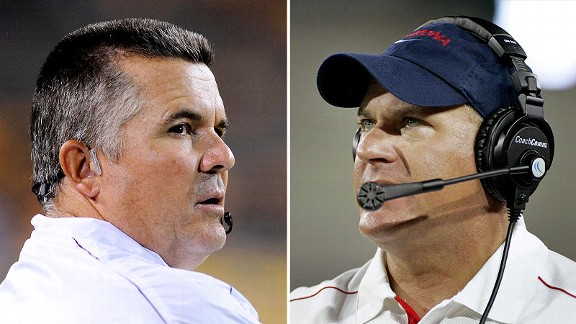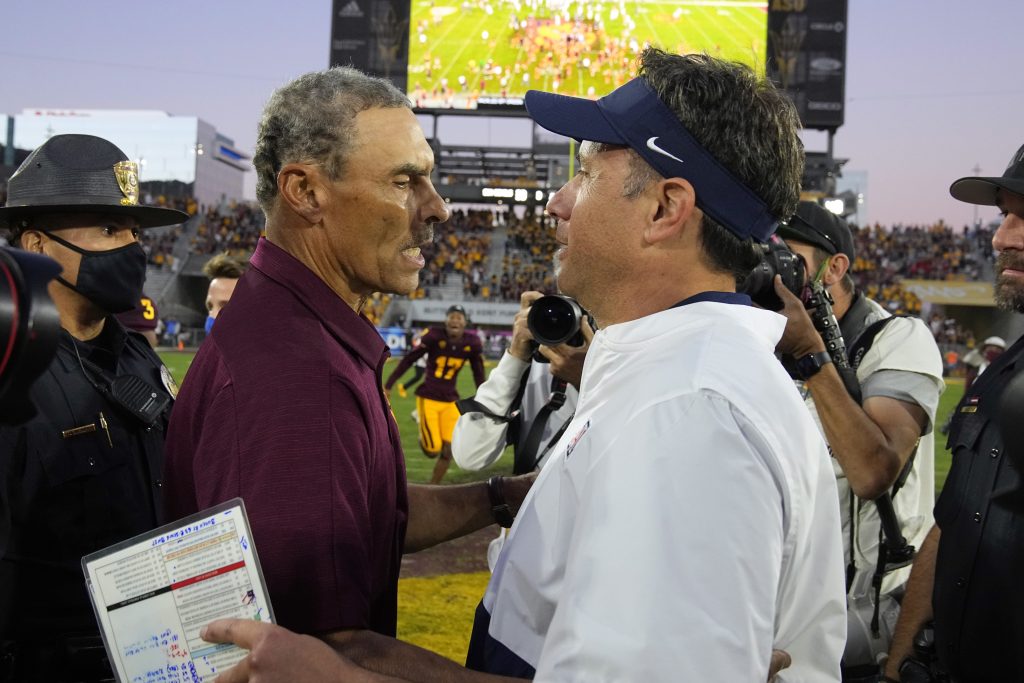The 2022 Pac-12 schedule was released Thursday, months earlier than recent editions and with a twist that should aid the competitive balance.
Here’s the master grid. Let’s dig in …
— The schedule is created by the conference office, with Merton Hanks, the senior associate commissioner for football operations, in the lead role.
Hanks and his team create several models, which are presented to the athletic directors for a vote. The winning model doesn’t necessarily make every school happy, but it makes the fewest number of schools unhappy.
— One of the best features of the 2022 schedule is the distribution of byes, which are clustered across four weeks in the middle of the season for every team except Stanford.
Once conference play begins, teams coming off a bye face opponents also coming off a bye in all but one case: Stanford doesn’t have a bye the week before it plays Arizona State.
As a result, there are no instances in which a team that played the week before has a road game against a home team coming off a bye — a significant competitive disadvantage that has been present in Pac-12 schedules in previous seasons.
— There are no weeknight conference games until the middle of November, when Colorado visits USC.
However, that could change in coming months. The Pac-12’s network partners, ESPN and Fox, could move a maximum of three games to Friday night.
— There are two major intersectional showdowns in Week One that will help frame the narrative for the conference. Both are on the other side of the country: Utah at Florida and Oregon vs. Georgia in Atlanta.
In all, the Pac-12 has 11 games against Power Five opponents, including Washington vs. Michigan State, Washington State vs. Wisconsin and Arizona against Mississippi State (with Mike Leach).
There are three games against Notre Dame. In addition to the annual matchups with USC and Stanford, the Irish will host Cal on the third Saturday of the season.
There is no return game in Berkeley in future years. The Bears took the money — approximately $2 million, according to USA Today — for a one-off visit to South Bend.
— Three teams face stretches in which they play three conference road games in a four-week span: Arizona State, Stanford and Washington.
— Every team plays back-to-back conference road games (with no bye in between) except UCLA and USC.
— Stanford has the most difficult schedule logistically, by far.
The Cardinal is the only team with a bye in September, forcing it to play 10 consecutive weeks. It faces USC, Oregon and Washington in the opening month, and it has two instances of back-to-back conference road games, although the second game of the second back-to-back is in Berkeley. (No other team plays back-to-back conference road games more than once.)
This year, USC had a bye before its mid-season trip to Notre Dame. Next year, Stanford visits South Bend after playing Washington, Oregon and Oregon State in back-to-back-to-back fashion.
— Toughest September: Oregon, which plays Georgia in Atlanta, Brigham Young and Eastern Washington at home and Washington State on the road.
— Toughest October: Stanford, which plays Oregon State and ASU at home and Oregon, Notre Dame and UCLA on the road.
— Toughest November: Colorado, which plays Oregon and Utah at home and USC and Washington on the road.
— Two rivalry games, the Territorial Cup and Oregon-Oregon State, are on the Friday after Thanksgiving, but the Apple Cup is not.
For the first time since 2017, Washington and WSU will duel on the Saturday of the holiday weekend.
— The cross-division schedule is the same as it was this season — meaning, for example, that USC does not play either Oregon or Washington.
The current rotation was set years ago and runs through the 2026 season.
— The defending division champions, Oregon and Utah, square off in Eugene on Week 12.
In other words, they once again could meet two times in three weeks, with the second matchup being the conference championship on Week 14 at Allegiant Stadium in Las Vegas.
— All in all, the schedule is fairly balanced in the distribution of marquee games — there are several in each month — and in the level of rigor.
That’s by design.
“Scheduling helps programs build themselves over time, if it’s applied correctly,” Hanks told the Pac-12 Network on Wednesday. “This isn’t a new situation. Administrators for decades have said, ‘Look, we have to adjust our schedule based on where my program is.’
“I’m loath to name names. But say, for instance, Oregon State, which has improved tremendously under the leadership of Jonathan Smith. Part of that is his leadership, his development of his players and, quite frankly, scheduling. We haven’t buried Oregon State with a schedule that doesn’t match where they are as a program.
“That’s how the conference office … all conference offices … try to view the individual membership — making sure the program, based where they are, is aligned from a scheduling standpoint so they aren’t getting hammered, ending up with a murderers’ row for schedules.”
Support the Hotline: Receive three months of unlimited access for just 99 cents. Yep, that’s 99 cents for 90 days, with the option to cancel anytime. Details are here, and thanks for your support.
*** Send suggestions, comments and tips (confidentiality guaranteed) to pac12hotline@bayareanewsgroup.com or call 408-920-5716
*** Follow me on Twitter: @WilnerHotline
*** Pac-12 Hotline is not endorsed or sponsored by the Pac-12 Conference, and the views expressed herein do not necessarily reflect the views of the Conference.
Related posts:

(AP Photo/Marcio Jose Sanchez)
Commissioner George Kliavkoff on the state of Pac-12 football (‘We’re in the valley’) Success of ASU, UA Boosting Pac-12 Football Status
Success of ASU, UA Boosting Pac-12 Football Status

(AP Photo/Ralph Freso, File)
Wilner Hotline: Sun Devils Missing in Action, Week 10 Pac-12 PicksJon Wilner
Jon Wilner has been covering college sports for decades and is an AP top-25 football and basketball voter as well as a Heisman Trophy voter. He was named Beat Writer of the Year in 2013 by the Football Writers Association of America for his coverage of the Pac-12, won first place for feature writing in 2016 in the Associated Press Sports Editors writing contest and is a five-time APSE honoree.
